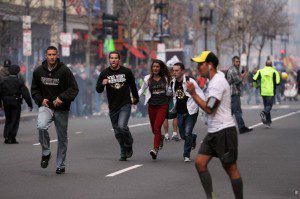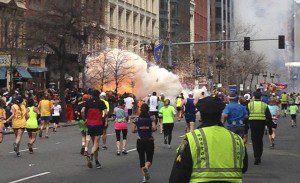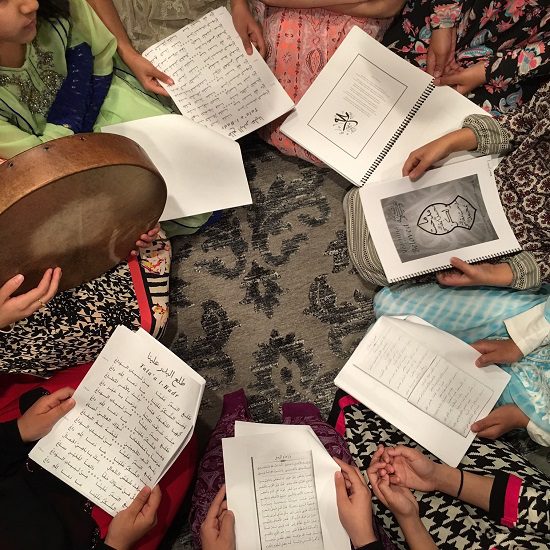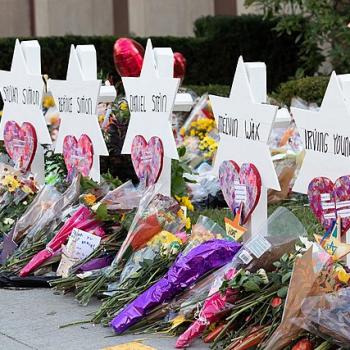By Obaid H. Siddiqui
“To him who is in fear, everything rustles.” — Sophocles
At about the 23rd mile of the Boston Marathon, Azeem Khan started receiving texts on his phone. The stream of messages weren’t out of the ordinary because he informed friends and supporters earlier via Facebook to text him with encouraging thoughts to get him through the grueling marathon.
Running for the American Liver Foundation, Azeem needed the extra push to get through the 26.2 mile gauntlet that stretches from the steep decline in Hopkinton through the winding roads of Ashland, into the rolling hills of Natick and on through the “Screech Tunnel” of encouraging onlookers in Wellesley, up and over “Heartbreak Hill” in Newtown, through the neighborhoods of Brighton and Brookline and culminating at the finish line in the city amid a roaring crowd of supporters.
When Azeem turned his attention to the buzzing phone, the texts he found weren’t the kind of supportive messages he was expecting. “Be safe,” one read. “Are you okay?” another one asked. At first, Azeem was confused. He looked around and noticed nothing odd about his surroundings – just other runners trying to make it to the finish line.
As he reached mile 24, about 10 minutes later, the texts began to make sense: The last two miles to the finish line, the path that cut through downtown Boston were quarantined off. Instead of the distant rumble of cheers and applause saved for the end of the marathon, a growing cacophony of ambulances, police, FBI, and SWAT members began to fill the air.
I Really Hope a Muslim Didn’t Do This
The news of what happened 10 minutes prior began to ripple through the crowd of runners looking forward to completing the race. Explosions. Smoke. Screams. Was it an accident? Was it an attack? An unfolding tragedy waited ahead. Azeem wasn’t sure what it was, but a subtle fear pulsed through him. Not a fear for his safety and health, but for what may come next. “I really hope a Muslim didn’t do this,” he thought to himself, not even fully knowing what “this” was at the moment.
The same thought occurred to Dr. Shereef Elnahal. The reverberation of the bombs awoke the young doctor, who lives close to the finish line. Working night rotations, the doctor maintained a demanding schedule overnight at the hospital and returned for a few hours of cherished sleep at his apartment during the day. Initially he thought the sounds that awoke him were from a construction crew. He soon turned on the television and was confronted with the horror outside his windows: A bomb had gone off near the finish line of the Boston Marathon.
Sensing his hospital, Brigham and Women’s, would soon be flooded with victims in need of critical care, he went into work early to assist in any way he could. As he got dressed he thought “I really hope this was not at the hands of a Muslim.”
Noora Hasan, a “bandit” runner in the marathon – one who wasn’t officially registered, but joined the race anyway – went into what she described as “survival mode” once she heard that bombs exploded at the finish line. The Wellesley senior, who has watched and cheered on the runners during her three previous years at the school, determined to exit the growing chaos surrounding her.
She walked to a nearby restaurant, asked first for a trash bag in which she could slowly cool her exhausted body and then for a phone to reach loved ones. Immediately upon realizing she was safe, the fear crossed her mind: she hoped that a Muslim wasn’t ultimately responsible.
Like Azeem, Shereef, and Noora, Muslims throughout America shared the fear the moment they heard of the tragedy. This better not be a Muslim, we all silently thought; please don’t let the culprit of this be someone justifying a horrific crime against humanity in the name of Islam. Each of us kept our faith close and lived our lives as Muslims in America, following every day routines, engaging with our communities, and disabusing non-Muslims of the notion that Islam equals violence. If this was an act of terror committed by a Muslim, the fear that all Muslims are prone to and support violence as an article of faith would certainly arise.

Stoking the Fear
The media was only too willing to oblige in stoking this fear. By Tuesday morning, the NY Post sensationally reported that a “Saudi national” was taken into custody and was a potential suspect. Despite the report being debunked – the “Saudi” was Abdul Rehman Ali Al-Harbi, a 20-year old student who was watching the race when the bombs went off and was hospitalized with severe burns to his hands – his name is still part of larger Muslim/Saudi conspiracy theories all over the internet.
By Wednesday afternoon, the media began to report increasingly egregious and false claims. Shortly after 1 p.m., CNN’s John King ominously reported on live television that a “dark-skinned male” was in custody. Even King knew his words seemed inflammatory; he attempted to soften the blow by acknowledging some viewers may find the phrase offensive, but was using “personal judgment” to deem the false report relevant.
The only two “facts” erroneously reported of the supposedly apprehended suspect – that he was male and had dark skin – had no journalistic value and served only to reinforce the xenophobic stereotype of a foreign menace. It was such a ridiculous report, that MSNBC’s Chris Hayes publicly excoriated CNN for such irresponsible journalism.
But the match to light the fear — that what we were facing was a dark-skinned Muslim man lurking within mainstream society awaiting orders to inflict deadly violence upon an innocent civilian population — had been struck.
Despite the corrections and backtracking, the image presented already began to take hold. It was only further intensified when, again, the NY Post published the image of Moroccan-American teenager Salah Eddine Barhoum on the cover of its Thursday issue, falsely connecting him with the attack. The narrative of a dark Muslim male as the perpetrator was so clear, that when authorities revealed the men believed to be the suspects later that same day, many American Muslims took a deep breath.
The images of Caucasian-looking men were somewhat of a relief, as later parodied by Aasif Mandvi for the Daily Show. In a spoof news report segment titled “Arrest Development,” Mandvi states “Thank God they weren’t Muslim.” Jon Stewart then clarifies for Mandvi that the suspects were in fact Muslim. “Yeah, but not Muslim Muslim,” responded Mandvi, referring to how the actual suspects, who are of Eastern European descent, didn’t fit the dark-skinned menacing Muslim image.
But that slight relief and cathartic comedy was only temporary. Tamerlan and Dzhokhar Tsarnaev were Muslim, and allegedly responsible for an attack that killed three and injured over 260 at the marathon, and for killing an officer during a robbery and shootout three days later.
Just as quickly as the men in the images were identified, their estranged uncle, Ruslan Tsarni, was holding an impromptu press conference in his Maryland driveway, denouncing his nephews as “losers.” Before knowing the full details of the story, Ruslan, fearful of the backlash his nephews may bring to his family, castigated the men as fools who fell under the effects of a virulent strain of jihadi rhetoric.
When Fear Drives the Discourse
Tsarni was smart to distance himself quickly because fear reared its insidious head again immediately. Heba Abolaban, a doctor of Palestinian descent, was punched by a man who shouted “F**k you Muslims” in the Boston area. Abdullah Faruque, a Bangladeshi man in the Bronx, was attacked by men who accused him of being Arab. Muhammad Salim, a Somali cab driver and Iraq War veteran, had his jaw broken by a man who threatened to “slice [his] f**king throat.”
The actual violence perpetrated on innocent Muslims throughout the country was only further inflamed by the ravings of television pundits like Ann Coulter, who stated that Tamerlan Tsarnaev’s widow, Katherine Russell, should be imprisoned simply for wearing a hijab. The Islamaphobes rushed from their caves of hate and fear to impugn Muslims and Islam as a threat to be handled outside of our laws and constitutional rights.
Fear once again followed, this time within the Muslim community. Imam Suhaib Webb, a well-respected and well-known Muslim-American leader who presides over the Islamic Society of Boston Cultural Center — a mosque Tamerlan reportedly attended at times — published a well-written op-ed in the New York Times distancing himself and the Boston community from the alleged bombers. So did the popular Pakistani-American writer, Wajahat Ali, who stated the Tsarnaev brothers were not the same as him and the vast majority of American Muslims.
Most disturbingly, Asra Nomani, writing for the Washington Post, drew a foolish and irrational conclusion by claiming the word Insha’Allah — Arabic for “God Willing” — was, when used increasingly, a red flag for radicalization. In effect, she was using Uncle Ruslan’s statement during his impromptu appearance that he noticed Tamerlan saying Insha’Allah more often as indicative of abnormal behavior. Nomani, who has sided with New York Congressmen Peter King in his witch hunt of Muslim Americans, irresponsibly opined that such a simple expression of religious faith should be judged with a watchful, untrusting eye.
Such fear followed Tamerlan to his grave, as mosques and cemeteries refused to bury his body, despite it being the obligation of a Muslim community to do so for its dead.
As the story of the Tsarnaev brothers began to unfold, a picture emerged of seemingly normal American young men. The elder was a Golden Glove boxer; the younger a well-liked, mild-mannered student at a local university. We were all left wondering: Why did they do this?
Fear made us not want to listen to the answer. According to hospital-bed confessions by Dzhokhar, which came after he was refused access to a lawyer, the “why” emerged: The brothers carried out the act in response to U.S. troops in Iraq and Afghanistan. The same rationale was used by Major Nidal Hassan, the Fort Hood killer; Najibullah Zazi, the attempted New York City subway bomber; Faisal Shahzad, the attempted Times’ Square bomber; and Umar Farouk Abdulmutallab, the attempted “underwear bomber.”
Fear Shouldn’t Stop Us from Confronting Hard Issues
We cannot be afraid to tackle the hard issues that we are confronted with in the wake of such attacks. We cannot be afraid to acknowledge the serious repercussions of our foreign policy abroad — not only in how it targets innocent foreign civilians, but how it motivates others, even Americans, to attack us. Fear tells us that seeking to examine the motivation of grotesque actions equates to justifying such acts. This is dangerously false.
If the Tsarnaev brothers are found guilty of the crimes that occurred the week of April 15th, starting with the bombing of the Boston Marathon and ending with the bloody shootout that left an officer dead and terrorized an entire city, then they deserve to be punished accordingly, and only God knows the punishment that awaits Tamerlan Tsarnaev in the afterlife. But, as the great Russian writer, Fyodor Dostoevsky once stated: “Nothing is easier than to denounce the evildoer; nothing is more difficult than to understand him.” We mustn’t fear to understand what drove these two men to act as they did.
The immediate condemnation of the murder of innocent people is necessary and driven by the Islamic imperative that to kill innocent people is to inflict murder upon all of humankind. Learning from the sustained backlash against Muslims and Islam in the wake of 9/11, Muslim organizations and individuals rightfully rushed to label the perpetrators as anti-Islam. Yet the essence of this public relations move, which in its swiftness subscribes to the very language of fear-mongering and stereotyping we abhor, is a manifestation of our fear as Muslim Americans.
We fear that any hesitation in declaring violent extremists as outside the fold of Islam will be used against us as proof of our sympathies for terrorists. A well-reasoned fear, but fear nonetheless. We must challenge these preconceived notions about what Islam is about. And as importantly, we must allow for an honest and provocative conversation about the development of a terrorist. In our haste to distance ourselves from such evil atrocities, we don’t allow ourselves to question the narrative presented to us.
The Tsarnaev brothers were Muslim, as am I. They were disgusted with U.S. foreign policy and the indiscriminate attacks on civilians throughout the Muslim world, as am I. Where we diverge is that they used a twisted, perverted, psychopathic logic to confront injustice perpetrated by our government leaders abroad and at home. While we must condemn their actions and punish them accordingly as well as others who use such tactics, we mustn’t fear to honestly examine why they followed the path they did. It is in seeking this knowledge that we will find the tools to combat such crimes.
Evil will never be conquered by fear; it will only be fueled by it. In order to defeat such evil, we have to understand it. Dr. Philip Zimbardo, the renowned psychologist who devised the Stanford Prison Experiment (SPE) and authored the insightful The Lucifer Effect — which used the lessons learned from SPE and Stanley Milgram’s Obedience to Authority experiment to astutely describe the dynamics that caused the horrific actions of the American men and women on watch at Abu Ghraib prison in Iraq — makes it clear: To understand what makes people do evil things, you have to focus on the interplay of three aspects: the dispositional, the situational and the systemic.
The dispositional refers to the individual — what about a person makes them commit an act? The situational looks for the cause within that individual’s environment. The third, and hardest to identify due to its vast nature, is the systemic. This examines on an institutional level what allows the disposition and situation to incubate such evil.
In Abu Ghraib, as Dr. Zimbardo points out, it was the interplay of the disposition (untrained military police) along with the situation (a dungeon prison under no supervision) within a system (an unwritten government ordinance that used illegal and immoral means in an attempt to extract information) that allowed the evil development of what occurred in that prison. Without acknowledging the interplay of these three elements, we will never come to understand why the Tsarnaev brothers did what they are suspected of doing.
As suggested by Sophocles, when we allow ourselves to be ruled by fear, we allow it to color our perception. The only way to avoid the fear that pulsed through Azeem, Shereef, and Noora; the fear that was exacerbated by erroneous reporting from the NY Post and CNN; the fear that caused the likes of Imam Webb and Wajahat Ali to distance themselves publicly from these men; the fear that caused Islamaphobes to denigrate the whole of the Muslim world and the religion of Islam; the fear that caused multiple Americans to attack their fellow innocent Americans based on their perception of Muslims; the fear that Asra Nomani finds in the simple exultation of God in Islam through the term Insha’Allah — is to understand that we are all capable of such.
Evil is plain and banal, and when the right elements within a human’s self, environment and institution coalesce, evil expands.
The distressing emotion of fear is aroused by impending danger, the anticipation of pain and the helplessness felt in the presence of a real or imagined threat. It is the feeling or condition of being afraid. Fear’s antidote is courage. We must reject the notion that to investigate the origins of why terrorists do what they do is to sympathize with them.
We must have the courage to not only ask but answer for ourselves these difficult questions. We can only do so when we discard the fear and fear-mongering and instead seek to understand the cause and motivation for acts of terror. Otherwise, the cycle will only continue. An enraged individual or group will inflict pain upon our citizenry, and we will, like clockwork, allow fear to keep us in a vacuum of ignorance. Everything serves to justify our fear, and in fear we justify everything. We must break this cycle.
Obaid H. Siddiqui is a freelance writer and independent journalist based in Philadelphia. He is a contributor to the anthology “All-American: 45 American Men on Being Muslim.”













